Filter by Category:
Search
Year
- Category: Research Reports
- Clear Filters
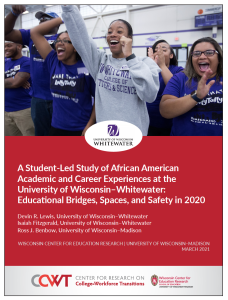 Lewis, D. R., Fitzgerald, I., & Benbow, R. J. (2021). A student-led study of African American academic and career experiences at the University of Wisconsin-Whitewater: Educational bridges, spaces, and safety in 2020. Center for Research on College-Workforce Transitions.
Lewis, D. R., Fitzgerald, I., & Benbow, R. J. (2021). A student-led study of African American academic and career experiences at the University of Wisconsin-Whitewater: Educational bridges, spaces, and safety in 2020. Center for Research on College-Workforce Transitions.
Summary: This report represents the findings from a student researcher-led project focused on the high school, college, and career preparation experiences of African American and Black college students at the University of Wisconsin–Whitewater (UWW), a predominantly White institution (PWI) in rural southeastern Wisconsin. With the goal of dismantling systemic barriers to equitable African American student college-to-career transitions, especially from PWIs, a team of three researchers designed and carried out a qualitative study to (1) collect African American student college and career narratives and (2) better understand African American students’ experiences at UWW. Key findings from the study include the elucidation of student perspectives on the strong connections between high school experiences, mostly in and around Milwaukee, and students’ college and career trajectories; the challenges involved in navigating campus spaces at a rural PWI; and the psychological, social, and educational effects of the COVID-19 pandemic, which is novel to 2020, and police racial profiling, which is not. The study also identifies key strategies for creating additional space for African American self-authorship, including through student organization advocacy and involvement, faculty and staff mentorships, and cross-campus and cross-community conversations.
 Hora, M. T., Wolfgram, M., Chen, Z., Colston, J., Ahrens, V., Rodriguez S., J., & Wetherbee, l. (2020). Results from the 1-year longitudinal follow-up analysis for the College Internship Study at Madison College. Center for Research on College-Workforce Transitions.
Hora, M. T., Wolfgram, M., Chen, Z., Colston, J., Ahrens, V., Rodriguez S., J., & Wetherbee, l. (2020). Results from the 1-year longitudinal follow-up analysis for the College Internship Study at Madison College. Center for Research on College-Workforce Transitions.
Summary: This report includes findings from the second round of data collection (Spring 2019 or T2) at Madison College for The College Internship Study, which is a national mixed-methods longitudinal study of internship programs conducted by the Center for Research on College-Workforce Transitions (CCWT) at the University of Wisconsin-Madison (UW-Madison). The data collected at T2 of the study include follow-up interviews with 8 students and a follow-up online survey of 147 students who participated in the first round of data collection (Spring 2018 or T1). These data are analyzed to provide faculty, staff, and leadership at Madison College with evidence-based insights about the impacts of internship participation on students’ lives and careers. Thus, this second round of the College Internship Study at Madison College is guided by the following research question: What are the changes concerning students’ internship experiences and outcomes comparing longitudinal data at two time points?
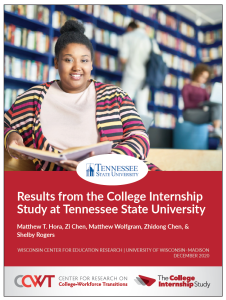 Hora, M. T., Chen, Z., Wolfgram, M., Chen, Z., & Rogers, S. (2020). Results from the College Internship Study at Tennessee State University. Center for Research on College-Workforce Transitions.
Hora, M. T., Chen, Z., Wolfgram, M., Chen, Z., & Rogers, S. (2020). Results from the College Internship Study at Tennessee State University. Center for Research on College-Workforce Transitions.
Summary: This report includes findings from the first round of data collection (Spring 2020) at Tennessee State University (TSU) for The College Internship Study, which is a national mixed-methods longitudinal study of internship programs conducted by the Center for Research on College-Workforce Transitions (CCWT) at the University of Wisconsin-Madison (UW-Madison). The findings are based on an interdisciplinary sample of students who took an online survey (n = 252), interviews with students who have and who have not had an internship experience (n = 9), and interviews with career advisors, faculty, and employers (n = 7). We would like to thank TSU for allowing our research team to conduct this study with your students, faculty, and community members, and hope that our findings are useful as you work towards improving internships and work-based learning for your students. As our research moves into its second year, we will focus on the impacts of the COVID-19 pandemic on the students, faculty and staff at TSU and employer partners with respect to internships and students’ overall experiences with the pandemic and its impacts on their studies and career goals.
Four research questions guide our study: (1) How many students are participating in internship programs, and does participation vary by student demographics, academic status, or life/employment situation? (2) What barriers exist for students to participate in internship programs? (3) What is the structure and format of internship programs? And, (4) How, if at all, is program structure and format associated with student satisfaction with their internships and their estimation of the value of the internship for their career development? In addition, given the timing of our interviews (Spring 2020), we also were interested in understanding TSU students’ experiences related to the COVID-19 pandemic.
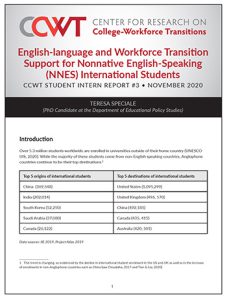 English-language and Workforce Transition Support for Nonnative English-Speaking (NNES) International Students. Speciale, T. (2020). Center for Research on College-Workforce Transitions Student Report #3. University of Wisconsin-Madison.
English-language and Workforce Transition Support for Nonnative English-Speaking (NNES) International Students. Speciale, T. (2020). Center for Research on College-Workforce Transitions Student Report #3. University of Wisconsin-Madison.
Introduction: Over 5.3 million students worldwide are enrolled in universities outside of their home country (UNESCO UIS, 2020). While the majority of these students come from non-English speaking countries, Anglophone countries continue to be their top destinations.
International students are drawn to foreign universities in search of credentials and academic and career opportunities unavailable in their home countries (ITA, 2016). The majority pursue degrees in STEM fields (in particular engineering, math, and computer science), followed closely by Business and Management (IIE, 2019). A prerequisite for admission to an English-speaking institution of higher education is English language proficiency, determined by standardized tests such as the Test of English as a Foreign Language (TOEFL) and the International English Language Testing System (IELTS). Continue reading.
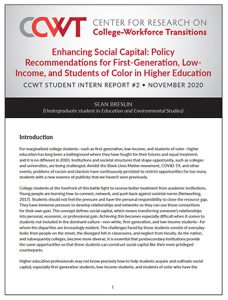 Enhancing Social Capital: Policy Recommendations for First-Generation, Low-Income, and Students of Color in Higher Education. Breslinang, S. (2020). Center for Research on College-Workforce Transitions Student Report #2. University of Wisconsin-Madison.
Enhancing Social Capital: Policy Recommendations for First-Generation, Low-Income, and Students of Color in Higher Education. Breslinang, S. (2020). Center for Research on College-Workforce Transitions Student Report #2. University of Wisconsin-Madison.
Introduction: For marginalized college students—such as first-generation, low-income, and students of color—higher education has long been a battleground where they have fought for their futures and equal treatment, and it is no different in 2020. Institutions and societal structures that shape opportunity, such as colleges and universities, are being challenged. Amidst the Black Lives Matter movement, COVID-19, and other events; problems of racism and classism have continuously persisted to restrict opportunities for too many students with a new essence of publicity that we haven’t seen previously.
College students at the forefront of this battle fight to receive better treatment from academic institutions. Young people are learning how to connect, network, and push back against societal norms (Networking, 2017). Students should not feel the pressure and have the personal responsibility to close the resource gap. They have immense pressure to develop relationships and networks so they can use these connections for their own gain. This concept defines social capital, which means transferring someone’s relationships into personal, economic, or professional gain. Achieving this becomes especially difficult when it comes to students not included in the dominant culture—non-white, first-generation, and low-income students—for whom the disparities are increasingly evident. The challenges faced by these students consist of everyday looks from people on the street, the disregard felt in classrooms, and neglect from faculty. As the nation, and subsequently colleges, become more diverse; it is essential that postsecondary institutions provide the same opportunities so that these students can construct social capital like their more privileged counterparts. Continue reading.
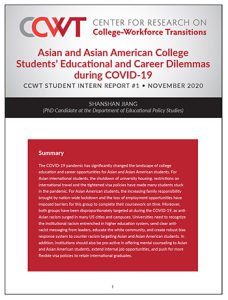 Asian and Asian American college students’ educational and career dilemmas during Covid-19. Jiang, S. (2020). Center for Research on College-Workforce Transitions Student Report #1. University of Wisconsin-Madison.
Asian and Asian American college students’ educational and career dilemmas during Covid-19. Jiang, S. (2020). Center for Research on College-Workforce Transitions Student Report #1. University of Wisconsin-Madison.
Summary: The COVID-19 pandemic has significantly changed the landscape of college education and career opportunities for Asian and Asian American students. For Asian international students, the shutdown of university housing, restrictions on international travel and the tightened visa policies have made many students stuck in the pandemic. For Asian American students, the increasing family responsibility brought by nation-wide lockdown and the loss of employment opportunities have imposed barriers for this group to complete their coursework on time. Moreover, both groups have been disproportionately targeted at during the COVID-19, as anti-Asian racism surged in many US cities and campuses. Universities need to recognize the institutional racism entrenched in higher education system, send clear anti-racist messaging from leaders, educate the white community, and create robust bias response system to counter racism targeting Asian and Asian American students. In addition, institutions should also be pro-active in offering mental counseling to Asian and Asian American students, extend internal job opportunities, and push for more flexible visa policies to retain international graduates.
 Arman, L., Benbow, R., Chughtai, M., Deeb, R., Fitzgerald, I., Lee, L., Lewis, D, Moua, P., Pasqualone, A., Thao, A., Toms, O., Siddiqui, K., Smolarek, B., Vang, M., Vivona, B., Wolfgram, M., Xiong, O., Xiong, P., Xiong, Y., & Yang, L. (2020). Engaging college students of color in higher education policy studies and advocacy: Preliminary results from three college student-led community-based participatory action research studies. Center for Research on College-Workforce Transitions.
Arman, L., Benbow, R., Chughtai, M., Deeb, R., Fitzgerald, I., Lee, L., Lewis, D, Moua, P., Pasqualone, A., Thao, A., Toms, O., Siddiqui, K., Smolarek, B., Vang, M., Vivona, B., Wolfgram, M., Xiong, O., Xiong, P., Xiong, Y., & Yang, L. (2020). Engaging college students of color in higher education policy studies and advocacy: Preliminary results from three college student-led community-based participatory action research studies. Center for Research on College-Workforce Transitions.
Abstract: This report describes the results from three college student-led community based participatory action research (CBPAR) studies. Each of the studies involved research partnerships between education mentors and college students of color, where students led the design and implementation of research about the college and career preparation experiences of their peers (fellow students of color at their own institution). The overall goal of the studies is for the student researchers to conduct research that could inform advocacy and policy change to benefit themselves and their fellow students. In this report, we present preliminary findings from the three ongoing studies on the college and career transitions experiences of (1) African American students at the University of Wisconsin-Whitewater, (2) Muslim American students at Northeastern Illinois University in Chicago, and (3) HMoob (also spelled “Hmong”) American students at the University of Wisconsin-Madison. The report details each study’s goals, significance, methods, and preliminary findings, followed by our conclusions and action items for postsecondary professionals and policymakers regarding the career-related experiences of college students of color.
 Chen, Z., Hora, M.T., Wu, Z., Ahrens, V., Rogers, S., & Wolfgram, M. (2020). Results from the College Internship Study at Benedict College. Center for Research on College-Workforce Transitions. UW-Madison.
Chen, Z., Hora, M.T., Wu, Z., Ahrens, V., Rogers, S., & Wolfgram, M. (2020). Results from the College Internship Study at Benedict College. Center for Research on College-Workforce Transitions. UW-Madison.
Abstract: This report includes preliminary findings from the first round of data collection for The College Internship Study, which is a mixed-methods longitudinal study of internship programs at Benedict College.
The study includes an online survey of students in the second half of their academic programs (n=114), focus groups with students who have and who have not had an internship experience (n=14), and interviews with career advisors and faculty (n=7). The research questions guiding this study focus on how stakeholders conceptualize and define the idea of internships, institutional capacity for administering internship programs, participation rates by certain student characteristics, and the relationship between internship program structure and student outcomes.
This report concludes with recommendations for specific steps that students, faculty and staff at Benedict College, and employers who supervise interns can take to increase participation rates, access, and program quality for internship programs.
